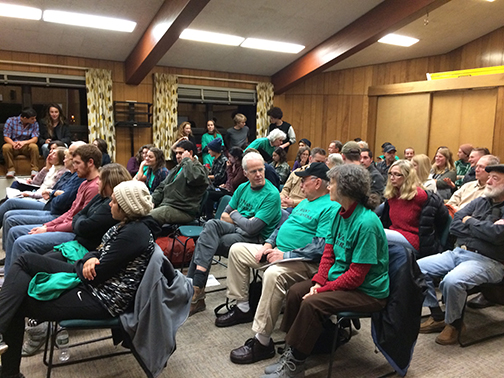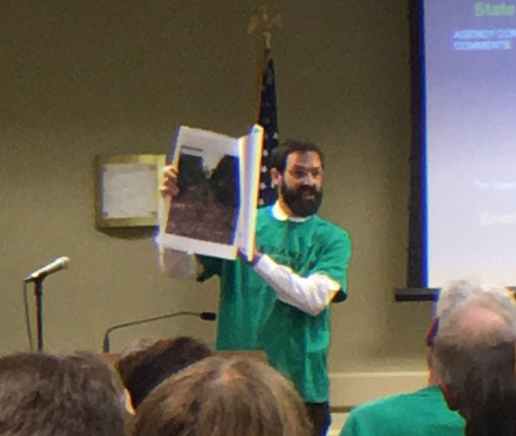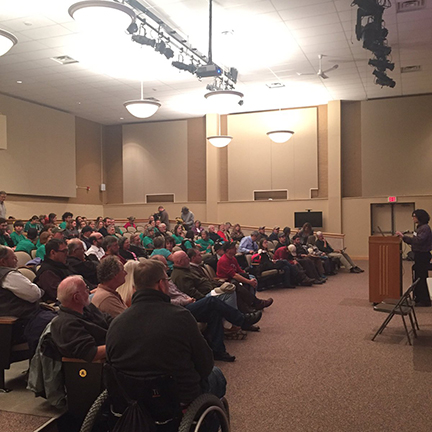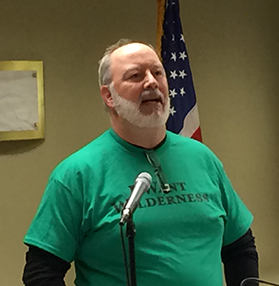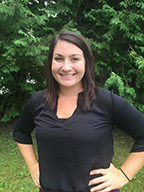
Adirondack Park Agency Concludes Public Hearings on Boreas Ponds Land Classification
By: Mary Godnick - Adirondack Council's Marketing and Development Assistant
December 13, 2016
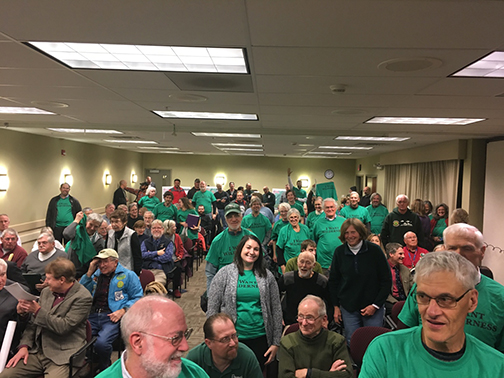
Albany HearingHundreds of people from across New York State turned out at hearings hosted by the Adirondack Park Agency (APA) in November and December to express their opinions on how the state should classify the Boreas Ponds tract and 101 other properties. A variety of themes, messages and issues were brought up at the hearings, but one thing rang true for everyone; a deep love for the Adirondacks. It was clear at every hearing, that people care for the Park’s communities, understand the importance of protecting our environment and have a connection to nature.
We would like to extend a huge thank you to everyone that has taken the time to write and speak about the Boreas Ponds classification. It is so important for the APA to hear your perspective when they are making a decision that will impact more than 20,500-acres of land owned by all New Yorkers.
Last Wednesday, the APA concluded their month long series of eight public hearings across the state from Canton to Bear Mountain, Northville to Rochester. Public hearings are a step in the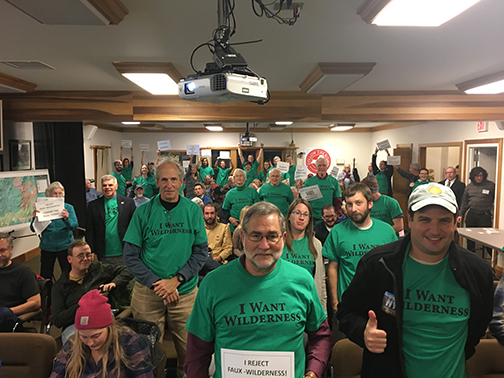
Ray Brook Hearing process to determine a legal classification category of each Forest Preserve parcel. The hearings intend to give people an opportunity to express their opinion, ask questions and provide information for the public record to help guide the APA's recommendation to the Governor about how new public lands should be classified to best protect their waters, land and wildlife and allow for recreation. Verbal comments become part of the official written record and the Agency is required to respond to comments and questions raised by the public. The APA must take them into account as they make their decision whether to adopt one of the proposed alternatives or develop one or more modified proposals.
At least 50 people signed up to speak at each of the public hearings. The APA heard from a wide variety of preferences on the Wilderness to motorized spectrum for the Boreas Ponds tract. Some people wanted the entire seven-mile Gulf Brook Road up to the Boreas Ponds opened up for motorized access. Some called for the closure of the entire Gulf Brook Road. Others called for solutions somewhere in between. At most of the public hearings, advocates calling for more Wilderness classification outnumbered those calling for motorized recreation and a Wild Forest designation.
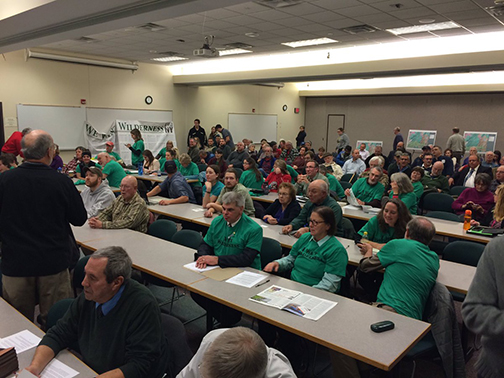 Rochester HeariingThere is a clear passion, especially among younger generations, for the expansion of Wilderness in the Adirondacks. Young residents and visitors of the Park had a strong showing at every hearing. Highlighting the benefits of an ultimate "full" Wilderness classification, they cited studies on the area's ability to withstand use and the unique opportunity to expand Wilderness. Retired Forest Ranger, Pete Fish mentioned in his public comment in Albany, I support Wilderness whenever and wherever. . . . Wilderness has a special sense, a special meaning and a very special magic about it. He expressed that the state's limited resources to manage such an area for uses other than foot traffic would result in nature reclaiming the roads, gravel pits and damns. Motorized advocates showed up to many hearings calling for Alternative 1, the most motorized-friendly option the APA offers. This would allow Gulf Brook road, which surrounds the Boreas Ponds, to remain completely open, potentially allowing cars, trucks and snowmobiles to drive to the shore and around the ponds. Under this proposal, the Boreas Ponds would be classified as Wild Forest instead of Wilderness. A Wild Forest classification would allow the most access to the Ponds by motor vehicles, and could cause a slew of issues including invasive species, noise pollution, overuse, and so on. Motorized advocates emphasized a need for a balanced approach that included compromise. Wilderness advocates responded by pointing out that Alternative 1 is not a compromise since the most fragile areas - the ponds themselves and the surrounding watershed - would be classified as Wild Forest and would not be protected from motorized use.
Each called for at least one mile of Wilderness protection for Boreas Ponds. The wildlife, water and fragile soils closest to the ponds and wetlands would be protected from degradation from tires, noise pollution and introduction of invasive species. They also suggested developing a hardened trail over the last mile to the Ponds to facilitate access for people with disabilities and provide the sense of discovery and remoteness of Wilderness.
Many advocates from both ends of the spectrum noted the APA's limited offerings of alternatives for Boreas Ponds. At the Newcomb hearing on November 16, Neil Woodworth Executive Director of the Adirondack Mountain Club said, "We believe there should have been more alternatives that more clearly reflected different dreams for the Boreas Ponds property." Business owners also highlighted the importance of Wilderness for local business. Peter Hornbeck of Hornbeck Boats spoke on the importance of Wilderness to his customers across the US, saying that his business is making $1 million in annual revenue and thriving because of Adirondack Wilderness. Third generation Adirondack business owner of Forever Wild Beverage Co. and Cascade Cross Country Ski Center Jennifer Jubin said, "the ADK economy depends on integrity and longevity of Wilderness." She noted that climate change is an issue that we need to prepare for, and determining a classification based on snowmobile recreation would not be wise. Others spoke about preserving the ecological integrity of the area and the impact of classification on native and threatened wildlife. Darryl McGrath Albany writer and author of "Flight Paths: a field journal of hope, heartbreak and miracles with New York's bird people" spoke for Wilderness protection of Boreas Ponds at the Albany hearing.
Additionally, Laurel Sherwood, an attendee of the Bear Mountain hearing, commented on the ecological risks of allowing motorized and mechanized recreation around the Ponds. She wrote, "I like to mountain bike (but) I am happy to refrain from biking in Wilderness areas. I think we should all be willing to give up some of our personal desires in order to serve the greater good." Many speakers focused on the benefits of environmental protection over personal preference of use. At the public hearing in Rochester on November 28, the room went silent as Paul Torrance spoke for Wilderness in a very powerful way, stating, "I am blind and aging, and the last thing I need at Boreas is the sound of motors. Sound is my experience." Another older gentleman emphasized, "I may never be able to get there, but please don't do anything special for me. I want Wilderness." A large number of speakers noted that they are either current or former residents of the Adirondack Park. Others came from both near and far to comment; traveling long distances in winter weather to speak. At the hearing in Northville, one Wilderness advocate from Buffalo, NY said, "I drove six hours to speak for three minutes in support of Wilderness." Another speaker at the Newcomb hearing mentioned that he flew in from Utah just to have his voice heard for Boreas Ponds.
While the public hearings are over, written comment will be accepted by the APA until December 30. Comments can be sent by email to ClassificationComments@apa.ny.gov or by mail to Kathleen Regan, Deputy Director, Planning, APA, PO Box 99, 1133 State Route 86, Ray Brook, NY 12977. You can also edit a sample letter and submit it to the Agency HERE. After the public comment period is over, all of the comments will be reviewed by members of the APA board of commissioners. Once the board's review is completed, they will likely vote for a preferred alternative at an APA meeting in late winter. From there, the preferred alternative will be sent to the Governor for approval, revision or rejection. Again, thank you to everyone that made it out to the hearings. Because so many people are passionate about the issue, many of the hearings ran for four to five hours. Thank you for taking the time out of your day to make your voice heard for Boreas Ponds. For more information on the land parcel, maps, alternatives, and environmental impact study click HERE.
|
||||

